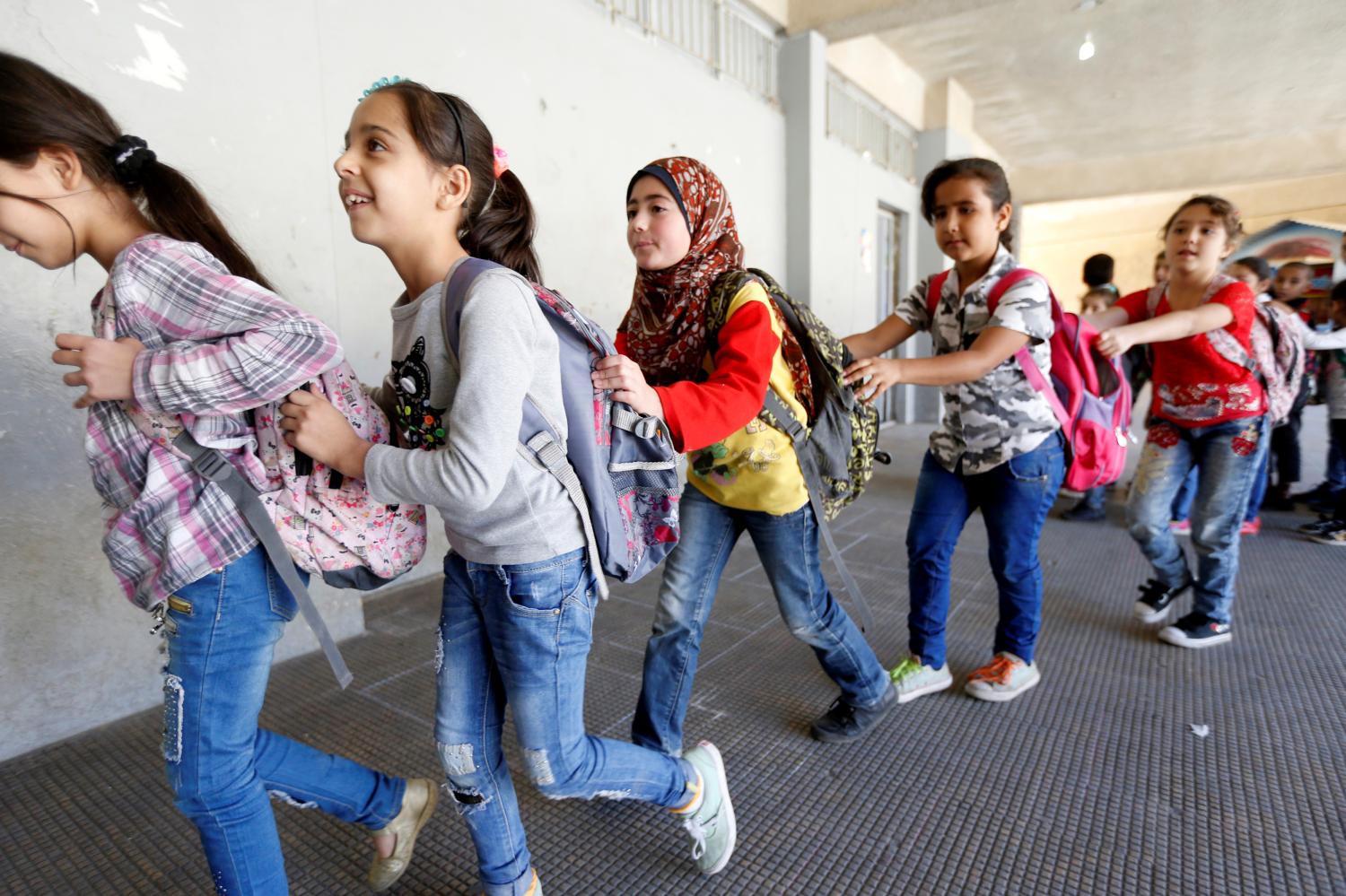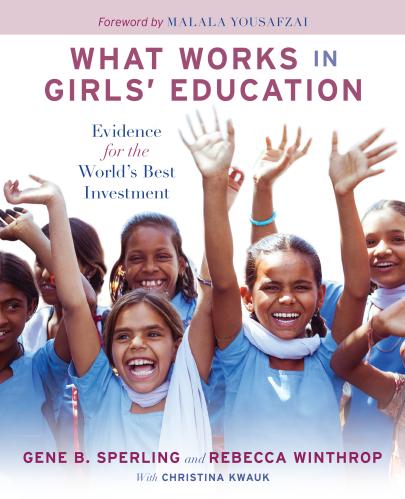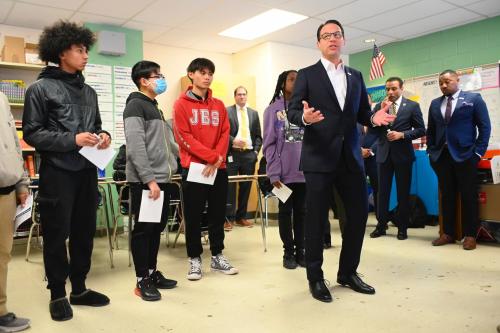The following brief is part of Brookings Big Ideas For America—an institution-wide initiative in which Brookings scholars have identified the biggest issues facing the country and provide ideas for how to address them. (Updated January 27, 2017)
 Helping lift up those around us demonstrates our commitment to human dignity and human rights; it is also in our national interest. Investing in education globally, especially for girls and women, is one of the best investments we can make and has a high return, with benefits across a range of areas—from global security to poverty reduction and economic stability to women’s empowerment and improved global health.
Helping lift up those around us demonstrates our commitment to human dignity and human rights; it is also in our national interest. Investing in education globally, especially for girls and women, is one of the best investments we can make and has a high return, with benefits across a range of areas—from global security to poverty reduction and economic stability to women’s empowerment and improved global health.
The Price of Ignorance
This past September, a report, The Learning Generation: Investing in Education for a Changing World, revealed that if we do not do something radically different, by 2030 half of the world’s youth—over 800 million—will not have the basic high school–level skills needed to succeed in the world of work.1 The bulk of these girls and boys will live in low- and middle-income countries. In fact, by 2030, in the poorest countries—from Afghanistan to Sudan—only 1 in 10 young people will have the basic skills he or she needs for a successful future. This is due to both limited access to schooling for the most marginalized and to the often poor quality of such education when it is available. Millions of children and youth are attending schools but are not mastering the competency they need, a problem that has serious implications for economic stability, peace and security, and women’s empowerment.
Unlike in previous generations, technological innovations now and in the future will lead to more job destruction than creation. The recently released Learning Generation report argues that over two billion jobs are at risk of automation in the coming decades. In this context, the demand for skills will be transformed, with more advanced skills at a premium and limited employer interest in low-order skills. Because of this, education systems must pivot and focus on preparing young people by cultivating the breadth of skills needed for the 21st century.2 Academic fundamentals will continue to be important, but so will competencies such as teamwork, problem solving, empathy, creativity, adaptability, and resilience. Fortunately, we know that cultivating a broader range of skills does not take away from academic achievement, but rather reinforces and improves it. Recent research in the learning sciences illustrates how young people who from an early age develop a range of competencies, from communication to critical thinking, are better at content mastery and academic success.3
The Rationale for U.S. Leadership
To date, no U.S. president has made global education one of his major signature initiatives, although the Obama administration made inroads in that direction. Moral imperative aside, investing in education globally brings the United States benefits across a range of areas, from global security to poverty reduction and economic stability to women’s empowerment and improvements in global health.
The timing is auspicious. Compared to eight years ago, the global education field has put in place key building blocks for success. There are now new measures for tracking the outcomes of global education efforts, along with new global coordination and investment mechanisms such as the reformed Global Partnership for Education (GPE), which kicks off a new strategy and replenishment cycle in 2017. The Obama White House, through its interagency Let Girls Learn initiative, laid the groundwork for a whole-of-government approach to education, and the U.S. Agency for International Development’s (USAID) current education strategy is undergoing a refresh. Global education is a topic that rises above partisan politics and appeals strongly to both sides of the aisle. By the end of 2016 the Education for All Act had unanimously passed the U.S. House of Representatives, and the Senate Foreign Relations Committee, showing global education to be one of the few issues in America to garner strong bipartisan support.
Returns on Investment
Improving education levels around the world, particularly for girls and women, plays an important role in helping address many of top global concerns facing the United States.
Peace and security. Studies have long demonstrated the effect that increased levels of education have on reducing a country’s risk of armed conflict. Indeed, higher levels of schooling within a population can significantly cut conflict risk. For example, an increase in secondary school enrollment from 30 percent to 81 percent is estimated to reduce the probability of civil war by almost two-thirds.4 It can even significantly reduce the length of existing armed conflicts, something borne out in a meta-analysis by coauthor Corrine Graff and I in the Brookings research report “Beyond Madrasas: Assessing the Links Between Education and Militancy in Pakistan.”5
Poverty reduction and economic stability. Investing in global education helps break intergenerational poverty and supports economic stability. UNESCO estimates that 171 million people could be lifted out of poverty if all students in low-income countries left school with basic reading skills—the equivalent of a 12 percent drop in world poverty.6
Improving education, particularly for girls and women, is also one important way to boost GDP. For example, a study of education levels from 1950 to 2010 found that an additional year of schooling for the average population could account for a 5 to 12 percent increase in economic growth; other studies have shown that GDP grows even faster when more women complete secondary schooling.7 The benefits of lifting people out of poverty in the developing world are felt globally. Indeed, high education levels outside the United States not only help bolster economic growth in other countries, they also bring direct economic benefits back to the United States itself. Harvard professor and Brookings non-resident fellow Martin West argues that improvements to the quality of education abroad would boost global productivity and lower the costs of imports, increase technological innovation to the benefit of American industry, and improve global stability.8 Studies have found that an overall increase in the skills of young people today would increase global GDP, growing both the global pie and America’s slice therein.
Global health. Improving education levels, especially for girls, is one of the most impactful interventions for addressing global health concerns. Dubbed the “social vaccine for HIV/AIDS,” girls’ education reduces the risk of HIV transmission, as better-educated women have more knowledge about how HIV is transmitted, helping them avoid infection and prevent their spreading it to their babies. Educating women and girls also helps reduce malaria, as women who are educated are more likely to use preventative measures such as bed nets. Improvements in girls’ education also have led to healthier families, and half the decrease in child mortality from 1970 to 2009 can be attributed to increased levels of girls’ education.9
Women’s rights and empowerment. It is the basic human right of all girls to be able to get a quality education. Currently, over 130 million girls are denied an education and an opportunity for a better life due to such things as early marriage, sexual slavery, crushing poverty, or simply living in out-of-reach areas. Quality education gives girls the skills they need to succeed in the changing world of work; it also has the power to help women better navigate the world around them and makes them better equipped to exercise their voice.
The Time Is Now
A move by the United States to invest big in education would send a strong signal about America’s commitment to human dignity globally. This visible investment, combined with the building blocks put in place over the past eight years and the ready-made global platform provided by the GPE replenishment, means that U.S. leadership would be catalytic for the sector. High-level leadership from the United States would be able to leverage and bring together new and stronger constituencies outside of the United States and allow for improved donor collaboration on education in the neediest and risky areas of the world.
Below is a selection of developments in the global education field over the past eight years that make it an opportune moment for fuller U.S. engagement.
Engaged Constituencies Ready to Partner
Education Commission. Global thought leaders from diverse walks of life—technology, academia, teaching, business, and politics—have mobilized through the international, high-level Education Commission.
United Nations. For the first time ever, the UN secretary-general has appointed a special envoy for global education, a position occupied for the past three years by former British prime minister Gordon Brown.
Civil society. Increasing numbers of internationally based civil society networks have been focusing on global education, which join the long-standing Basic Education Coalition, a group of almost 25 U.S.-based global education implementers and the Global Campaign for Education–U.S., a coalition of more than 80 U.S. organizations dedicated to ensuring universal access to quality education.
Teachers. Teachers and their organizations are more engaged at the policy level within the global education community. Through Education International, the global federation of teacher unions and organizations, teachers have a seat at the table at the major global policy dialogue forums and are actively engaged in codeveloping solutions together with government leaders.
Foundations and business. New coalitions of philanthropic and business actors have come together to support global education to find better opportunities for collaboration and partnership. Some of these include the International Education Funders Group, the Global Business Coalition for Education, and the Global Compact on Learning Donor Network.
Education Outcomes—Data and Measurement
With 193 countries signing on to this ambitious goal, there is more support than ever before for improving the skills and competencies of all children and youth.
Sustainable Development Goal (SDG) 4. The SDGs, and the accompanying implementation roadmap, the Education 2030 Framework for Action, have clearly placed improving learning outcomes and skills squarely on the global agenda.10 With 193 countries signing on to this ambitious goal, there is more support than ever before for improving the skills and competencies of all children and youth.
New measurement tools. A broad-based global initiative to develop better shared measures for learning progress has spurred progress on a shared commitment to tracking learning and developing new tools to do so. For example, there is a new shared tool—Measuring Early Learning Quality and Outcomes—to assess the quality of early childhood development.11 There are also new measures for understanding inequities in education access and outcomes from UNESCO’s World Inequality Database on Education to FHI-360 and Save the Children’s Education Equity Research Initiative.
Global tracking of student learning. For the first time ever, the international body that tracks global education data, UNESCO’s Institute for Statistics, is monitoring data on learning outcomes and on who is enrolling in early childhood programs and school.
Multilateral Mechanisms
GPE. Newly relaunched in 2011, the Education for All Fast Track Initiative became the GPE, with a new governance mechanism and global role in coordinating global education efforts to strengthen education systems. GPE today is a multistakeholder partnership and funding platform operating in 65 low-income countries.
Education cannot wait. Launched this year at the World Humanitarian Summit in Istanbul, the Education Cannot Wait fund aims to provide education to over 13 million children and youth living in emergencies and protracted crises by 2030. To date, a range of countries have committed to supporting crisis-affected children through this mechanism, including the United States, the United Kingdom, Norway, the Netherlands, the European Union, Denmark, and Canada.
U.S. Initiatives to Build On
Let girls learn. As mentioned previously, through the efforts of First Lady Michelle Obama the White House has recently sought to elevate the issue of education for adolescent girls through its Let Girls Learn initiative. The initiative works across agencies and as such lays important groundwork for the incoming Trump administration to build and strengthen a high-level global education initiative.
Reading. Primarily through USAID, the United States has moved the agenda forward on improving reading levels for children in developing countries by working on a range of issues from measurement to teacher training to availability of books.
Refugees. The State Department and USAID have ongoing programs supporting education for refugee children and children who are internally displaced and otherwise affected by crisis, from armed conflict to natural disasters.
Education for All Act. Enjoying broad bipartisan support, the Education for All Act puts forward a strong commitment to global education goals and key principles.12 The act was passed unanimously by the House of Representatives and the Senate Foreign Relations Committee by the close of 2016.
International Basic Education Caucus. One of the newest caucuses, the International Basic Education Caucus, enjoys bipartisan sponsorship and support and provides a useful mechanism for advancing global education issues in the U.S. Congress.13
A Global Education Initiative with Girls and Women at the Center
A significant global education initiative cannot only help our global health investments to be more effective, but also can catalyze change for communities around the world and pay back dividends to the United States in multiple ways. The Trump administration should lead globally by establishing a presidential initiative on global education that uses an interagency approach to position education as a centerpiece in U.S. foreign assistance.
WHO: Women and Girls at the Center
This initiative should place girls and women at its center for two main reasons. First, it needs to ensure that global education programming reaches and fosters relevant learning outcomes for girls and is a way of recognizing that girls have a long-standing legacy of discrimination and underinvestment to overcome. Second, it must recognize that educating girls and women is one of the best investments the world can make because it yields high returns. Strong evidence shows that improving girls’ and women’s education levels leads to better lives for children, families, communities, and countries. In What Works in Girls’ Education: Evidence for the World’s Best Investment, my coauthor Gene Sperling and I find that girls’ education increases economic growth, improves jobs and wages, saves mothers’ and children’s lives, leads to smaller and more sustainable families, results in healthier and better-educated children, reduces rates of HIV/AIDS and malaria, reduces rates of child marriage, empowers women, increases women’s political leadership, and reduces harm to families from natural disasters and climate change.14
WHAT: Developing Breadth of Skills across the Lifecycle
The initiative must focus on giving young people the skills they need to thrive in a changing world. This requires not only building schools and increasing enrollments but also helping children and youth develop the breadth of skills needed for work and life, inclusive of academic competency and other essential 21st-century skills.15 While the scaling-up of education in developing country contexts has mostly focused on increasing access to school, effective models for scaling up improvements in quality learning do exist.16 With the right programmatic and policy design, learning outcomes across the breadth of skills can be improved. To achieve this goal, however, a lifecycle starting from early childhood to formal schooling to youth workforce development is required. The foundations for children’s 21st-century skills and academic success are laid early, before children ever enter school. Recent estimates find that there are 250 million children under age 5 who are at risk of not meeting their developmental potential.17 These recent studies find that the effects of such developmental delays impact brain development that can be seen in the first year, but worsen throughout childhood and persist throughout life. In fact, an earlier study estimated that developmental delays result in a 19.8 percent deficit in adult income.18
Two hundred and sixty-three million children and youth of school age are currently out of school, and even more strikingly, 479 million are enrolled in school but are not achieving basic learning outcomes.
As children grow, these education deficits persist. There continue to be a large number of children and youth who are not in primary and secondary school, and millions more who despite attending school are not gaining even basic reading and math skills. Two hundred and sixty-three million children and youth of school age are currently out of school, and even more strikingly, 479 million are enrolled in school but are not achieving basic learning outcomes.19 For the 142 million youth who today are not in school and likely never to return, alternative pathways such as skills training and workforce development are crucial.
WHERE: Communities with Greatest Need, Including Fragile States
Today we are in the midst of the greatest refugee crisis since World War II: over 60 million people have been forced to leave their homes and flee to another country. Any global education initiative must take seriously how to support the communities most in need. This includes those affected by armed conflict and disaster as well as those who may live in more stable contexts but are chronically marginalized.
HOW: Mutually Reinforcing Bilateral and Multilateral Approaches
The initiative should leverage both bilateral and multilateral channels of support. Bilateral mechanisms can allow for greater flexibility for advancing U.S. policy in the world and should continue to be an important mechanism for supporting children’s education globally. However, the initiative should add to this existing bilateral work by ramping up its support of currently underfunded multilateral mechanisms like GPE and the Education Cannot Wait fund. Often in places where U.S. support is needed most, there is weak local governance, and support through bilateral mechanisms can be effectively complemented by multilateral mechanisms.
Conclusion
We should never underestimate the importance of investing in children and youth. Quality early childhood development and education are pivotal for putting young people on a path to success that contributes to vibrant societies. Far too many children are excluded from these opportunities and ultimately from a positive future. The next U.S. administration has an opportunity to capitalize on the groundwork that has been laid over the past eight years and make a significant difference for the education of young people around the globe, particularly for girls and women. This would be a historic contribution to the future of our children and an important contribution to our collective global prosperity.
-
Footnotes
- See the report of the International Commission on Financing Global Education Opportunity at http://report.educationcommission.org/report/.
- Rebecca Winthrop and Eileen McGivney, “Skills for a Changing World” (Brookings, May 19, 2016).
- See Robert Michnick Golinkoff and Kathy Hirsh-Pasek, Becoming Brilliant: What Science Tells Us about Raising Successful Children (American Psychological Association, 2016).
- Clayton L. Thyne, “ABC’s, 123’s, and the Golden Rule: The Pacifying Effect of Education on Civil War, 1980–1999,” International Studies Quarterly 50 (2006): 733–54, www.uky.edu/~clthyn2/thyne-ISQ-06.pdf.
- Rebecca Winthrop and Corinne Graff, “Beyond Madrasas: Assessing the Links between Education and Militancy in Pakistan” (Brookings, June 23, 2010).
- Teaching and Learning: Achieving Quality for All (UNESCO, 2014), http://unesdoc.unesco.org/images/0022/002256/225660e.pdf.
- Gene B. Sperling and Rebecca Winthrop, What Works in Girls’ Education: Evidence for the World’s Best Investment (Brookings Institution Press, 2015).
- M. R. West, “Education and Global Competitiveness,” in Rethinking Competitiveness, edited by K. Hassett (Washington, D.C.: American Enterprise Institute Press). An excerpt of this paper also appears in Martin R. West, “Global Lessons for Improving U.S. Education,” Issues in Science & Technology 28, no. 3 (2012): 37–44.
- Emmanuela Gakidou, Krycia Cowling, Rafael Lozano, and Christopher J. L. Murray, “Increased Educational Attainment and Its Effect on Child Mortality in 175 Countries between 1970 and 2009: A Systematic Analysis,” The Lancet 376, no. 9745 (2010): 959–74, http://dx.doi.org/10.1016/S0140-6736(10)61257-3.
- “High-level Meeting on the Education 2030 Framework for Action” (UNESCO, 2016), www.unesco.org/new/en/education/themes/leading-the-international-agenda/education-for-all/education-2030-framework-for-action/.
- See information on the Measuring Early Learning Quality and Outcomes project on the “Readiness to Learn” website of the Learning Metrics Task Force, Brookings Center for Universal Education, brookings-edu-2023.go-vip.net/learning-metrics-task-force-2-0/readiness-to-learn/.
- H.R. 4481, Education for All Act of 2016, September 7, 2016, www.govtrack.us/congress/bills/114/hr4481.
- “The Path to Quality Education for All” (International Basic Education Caucus, Results, 2015), www.results.org/uploads/files/IC_2015_Education_Caucus.pdf.
- Sperling and Winthrop, What Works in Girls’ Education.
- Christina Kwauk and Amanda Braga, “Are We Offering a Breadth of Skills in Girls’ Education Programming?” (Brookings, October 11, 2016).
- Jenny Perlman Robinson, Rebecca Winthrop, and Eileen McGivney, “Millions Learning: Scaling up Quality Education in Developing Countries” (Brookings, April 13, 2016).
- Maureen M. Black and others, “Early Childhood Development Coming of Age: Science through the Life Course,” The Lancet (online first), October 4, 2016, http://dx.doi.org/10.1016/S0140-6736(16)31389-7.
- Sally Grantham-McGregor and others, “Developmental Potential in the First 5 Years for Children in Developing Countries,” The Lancet 369, no. 9555 (2007): 60–70, http://dx.doi.org/10.1016/S0140-6736(07)60032-4.
- “Target 4.1: Primary and Secondary Education,” Global Education Monitoring Report (UNESCO, 2016), http://gem-report-2016.unesco.org/en/chapter/target-4-primary-and-secondary-education/.
The Brookings Institution is committed to quality, independence, and impact.
We are supported by a diverse array of funders. In line with our values and policies, each Brookings publication represents the sole views of its author(s).





